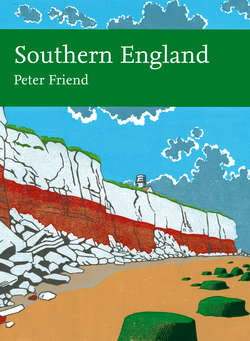Читать книгу Southern England - Peter Friend - Страница 40
Landscape B: Killas and other Devonian bedrock
ОглавлениеApart from the granites, Devonian sediments make up the bedrock of the southern and central part of Area 2. They consist largely of slates and mudstones with some sandstones, and are known generally as killas to distinguish them from the granites and other younger, less altered sediments. In a few localities around Plymouth (b1) there are Devonian limestones, similar to the well-known limestones around Torquay (d1) and Chudleigh (d9). The settings in which these Devonian sediments may have formed are illustrated in Figure 38, in the general section of this chapter.
The youth of the coastal scenery of this Landscape combines with the vigour of many of the processes operating to make it much more distinctive and dramatic than the inland scenery. In the west of Area 2, cliffs characterise the Cornish section of the south coast and often intersect deeply incised valleys that are clearly older features (Fig. 71).
Cornwall and Devon are separated from each other in this Area by the River Tamar, and this meets the south coast in a large drowned valley system around which Plymouth (b1) has grown (Fig. 72). Plymouth Sound is one of the best natural harbours in the Southwest and the historical naval importance of this city is the result. Similar, but smaller, valley systems (sometimes called rias) are common all along this stretch of coast, as they are further west in Area 1. Flooded valleys form the estuaries of the River Fowey, east of St Austell, and farther east still at Salcombe (b3) and Dartmouth (b8).
FIG 71. Polperro, on the south Cornwall coast. (Copyright Dae Sasitorn & Adrian Warren/ www.lastrefuge.co.uk)
FIG 72. The Tamar and Brunel Bridges, between Plymouth (Devon), to the right, and Saltash (Cornwall). (Copyright Dae Sasitorn & Adrian Warren/www.lastrefuge.co.uk)
The headlands from Bolt Tail (b2) to Start Point (b5) are made of some of the most highly altered and probably oldest bedrock in Devon, although the age of their deposition as sediments is not known. They have been changed locally to mica-rich and hornblende-rich schists that must have been altered (metamorphosed) several kilometres below the surface, before being pushed upwards during the Variscan mountain-building event. The local resistance of these schists to erosion has led to a particularly intricate pattern of small but sharp headlands and tight small bays. The slope map (Fig. 78) reveals a strong east-west orientation of slopes in this area that must be a reflection of folding in the bedrock. Three separate coast platforms, the highest at about 7 m above present sea level, are very clear at Sharpers Head (b4). Each platform represents an episode in the retreat and relative lowering of the sea before the latest Flandrian rise.
FIG 73. Slapton Sands (Fig. 66, b7). (Copyright Dae Sasitorn & Adrian Warren/www.lastrefuge.co.uk)
Just north of Start Point (b5) lies the ruined village of Hallsands (b6), which vividly illustrates the damage people can unwittingly do in changing features of the coastal zone. From 1897 to 1902 over half a million tonnes of gravel were removed from the bay off Hallsands to construct an extension to the dockyard at Plymouth. Engineers believed that natural storm currents offshore would replenish the material they had taken, but this did not happen. Instead, the removal of the shingle left the beach open to intense storm erosion, and in January 1917, some 15 years later, the lower part of the village and a sizeable section of coastline were removed by a combination of storm and tide conditions.
Further north, the 3.5 km long barrier beach of Slapton Sands (b7) is another shingle barrier kept active by storm waves from the southeast (Fig. 73). The freshwater lagoon behind it, Slapton Ley, is a nature reserve, home to many rare species of plants and animals. It is under threat from erosion and breaching of the shingle barrier, causing flooding by salt water, and from silting up because of ploughing and deforestation of the inland landscape.
This Landscape of Area 2 also includes a short section of the north Cornish coast around Tintagel (b9), which was an important trading centre on this difficult coast and became the site of a twelfth-century Norman castle, linked to the legends of King Arthur (Fig. 74). The coastline here is often sheer and rugged, and the bedrock contains sharp folds, fracture surfaces and multiple surfaces of mica-rich cleavage, providing evidence of extreme compression during the Variscan mountain building. Many of the cliffs are flat-topped, because erosion has been controlled by relatively flat-lying surfaces in the bedrock, which contrasts sharply with the hog’s-back or whaleback cliffs of other coastal stretches.
